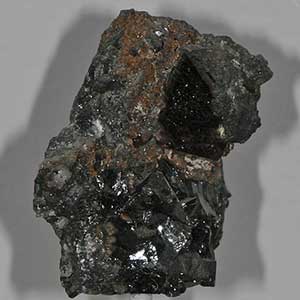In the modern periodic table, the elements are listed in order of increasing atomic number. The atomic number is the number of protons in the nucleus of an atom. The number of protons define the identity of an element (i.e., an element with 6 protons is a carbon atom, no matter how many neutrons may be present). The number of protons determines how many electrons surround the nucleus, and it is the arrangement of these electrons that determines most of the chemical behavior of an element.
- Germanium (Ge) Atomic Data for Germanium (Ge) Atomic Number = 32 Atomic Weight = 72.61 Reference E95: Isotope: Mass: Abundance: Spin: Mag Moment: 70 Ge.
- Our germanium page has over 240 facts that span 97 different quantities. Each entry has a full citation identifying its source. Areas covered include atomic structure, physical properties, atomic interaction, thermodynamics, identification, atomic size, crystal structure, history, abundances, and nomenclature.
In a periodic table arranged in order of increasing atomic number, elements having similar chemical properties naturally line up in the same column (group). For instance, all of the elements in Group 1A are relatively soft metals, react violently with water, and form 1+ charges; all of the elements in Group 8A are unreactive, monatomic gases at room temperature, etc. In other words, there is a periodic repetition of the properties of the chemical elements with increasing mass.
In the original periodic table published by Dimitri Mendeleev in 1869, the elements were arranged according to increasing atomic mass— at that time, the nucleus had not yet been discovered, and there was no understanding at all of the interior structure of the atom, so atomic mass was the only guide to use. Once the structure of the nucleus was understood, it became clear that it was the atomic number that governed the properties of the elements.
| The most common use of germanium is as a semiconductor in electronics. |
Germanium
Germanium fluoride (GeF 2) Germanium dioxide (GeO 2) Germanium hydride (Ge 2 H 6) Germanium tetrachloride (GeCl 4) Interesting facts: In its natural state it is brittle and crystalline. It is a gray-white metalloid. It is less abundant than either tin or lead. Its ores are rare. It's an element that was predicted by Mendeleev in 1871. Converter audio cd in mp3 for mac.
| Atomic Number: | 32 | Atomic Radius: | 211 pm (Van der Waals) |
| Atomic Symbol: | Ge | Melting Point: | 938.25 °C |
| Atomic Weight: | 72.64 | Boiling Point: | 2833 °C |
| Electron Configuration: | [Ar]4s23d104p2 | Oxidation States: | 4, 3, 2, 1, 0, −1, −2, −3, −4 (an amphoteric oxide) |

Gallium Atomic Number
History
From the Latin word Germania, Germany. Mendeleev predicted the existence of Germanium in 1871 as ekasilicon, and the element was discovered by Winkler in 1886.
Sources
The metal is found in
- argyrodite, a sulfide of germanium and silver;
- germanite, which contains 8 percent of the element;
- zinc ores;
- coal; and
- other minerals
The element is commercially obtained from the dust from smelters that process zinc ores. It is also recovered from combustion by-products of certain coals.
Germanium can be separated from other metals by fractional distillation of its volatile tetrachloride. These techniques permit the production of germanium of ultra-high purity.
Properties
The element is a gray-white metalloid. In pure state, the element is crystalline and brittle, retaining its luster in air at room temperature. It is a very important semiconductor. Zone-refining techniques have led to production of crystalline germanium for semiconductor use with an impurity of only one part in 1010.
Uses
When germanium is doped with arsenic, gallium, or other elements, it is used as a transistor element in thousands of electronic applications. The most common use of germanium is as a semiconductor. Germanium is also finding many other applications including use as an alloying agent, as a phosphor in fluorescent lamps, and as a catalyst.
Germanium Whose Atomic Number
Germanium and germanium oxide are transparent to the infrared and are used in infrared spectroscopes and other optical equipment, including extremely sensitive infrared detectors.
Germanium Atomic Mass
The high index of refraction and dispersion properties of its oxide's have made germanium useful as a component of wide-angle camera lenses and microscope objectives.
Germanium Atomic Number
The field of organo-germanium chemistry is becoming increasingly important. Certain germanium compounds have a low mammalian toxicity, but a marked activity against certain bacteria, which makes them useful as chemotherapeutic agents.
